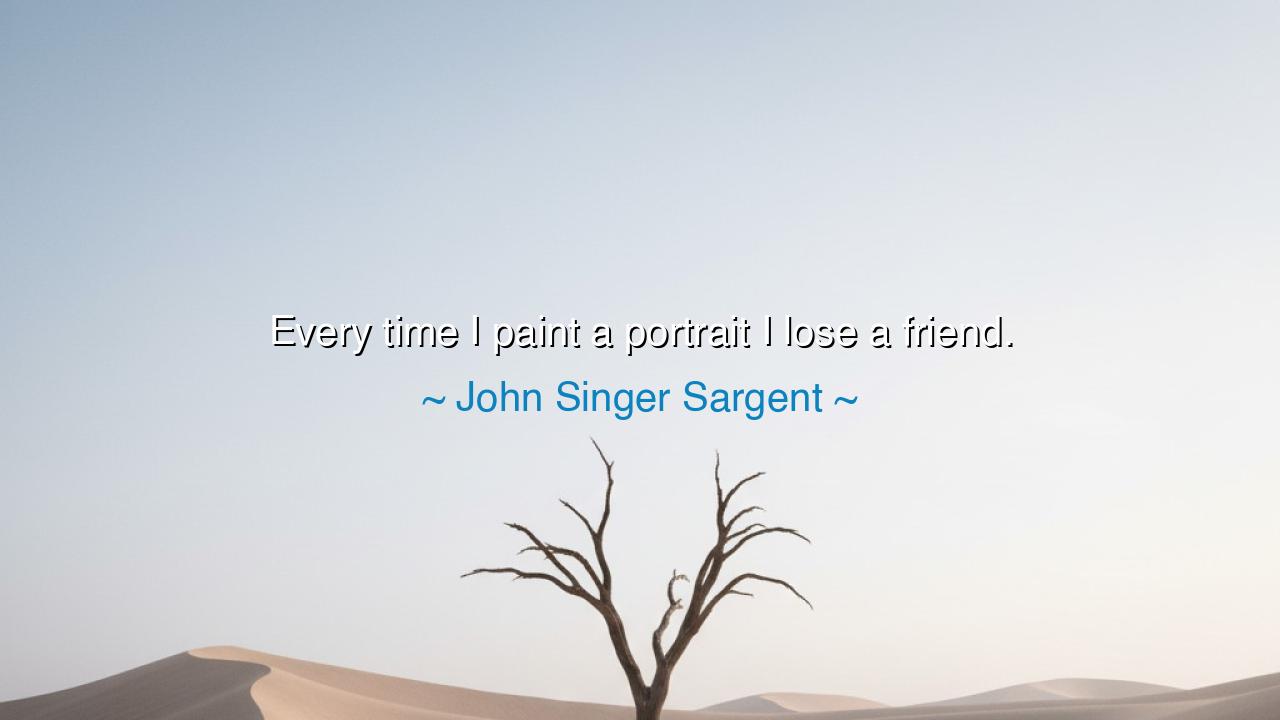
Every time I paint a portrait I lose a friend.






"Every time I paint a portrait I lose a friend." - John Singer Sargent. These words, spoken by one of the most celebrated portrait artists of the late 19th and early 20th centuries, reveal a profound truth about the nature of art, friendship, and the vulnerability inherent in both. For Sargent, the act of painting was not merely a technical endeavor; it was an intimate exposure of the subject, one that stripped away the facade and revealed the true essence of the individual. In capturing the likeness of his subjects, he not only immortalized their external appearance but also, perhaps, laid bare their character, something that many may not have wished to be seen by the world. This vulnerability, this revelation of the soul, is what caused the rift between the artist and his friends, for they were no longer just faces in a crowd—they were subjects to be scrutinized, analyzed, and immortalized in ways that might make them uncomfortable.
Consider the life of Queen Elizabeth I, who was often depicted in portraits that emphasized her regal strength, yet also captured the lonely, guarded nature of her reign. The artists who painted her did not simply reflect her physical appearance; they imbued their works with the political and emotional weight of her rule. For Elizabeth, her portraits were not merely artistic representations but tools of power and projection. When an artist like Sargent painted someone, there was a similar process of revealing the internal complexities that lay beneath the surface. This revelation, while invaluable as art, came at a price—the price of intimacy, of exposure, and often, of distance in the relationship.
This sentiment is reflected in the broader human experience, for we know that the act of truly seeing and understanding someone is a double-edged sword. To be seen in all one’s truth is both a gift and a burden. We long to be understood, but when that understanding reveals our imperfections, our fears, or our insecurities, we may shrink from it. In a way, Sargent’s portraits were a mirror to the soul, and to gaze upon that reflection was to see oneself through a lens of unflinching honesty. It is no wonder, then, that in the wake of such intimate exposure, relationships could fracture. Just as the Greek philosophers taught that self-knowledge can be both a source of wisdom and suffering, so too could Sargent’s portraits bring a painful awareness of the self.
Consider the example of Henry James, the American writer who was not only a contemporary of Sargent but also a close friend. Sargent painted James several times, and though James was known for his sharp intellect and emotional complexity, the portraits often revealed a more reserved, even vulnerable, side of his personality. The very act of being painted—of being so intensely scrutinized and immortalized—can stir anxiety, for it demands that one confront the truth of one’s own existence. The relationship between Sargent and James became strained over time, not because of malice, but because the portraits exposed a truth that was difficult to bear, even between friends.
The lesson from Sargent’s words is multifaceted. It tells us that art—true art—does not merely capture the surface; it penetrates deeper, revealing the truths we often keep hidden. Whether it is through the painted portrait, the written word, or any other form of expression, art demands that we expose our vulnerabilities and confront what lies beneath. In doing so, it offers the opportunity for growth, but also brings the risk of alienation. Relationships, particularly those based on intimacy, are fragile and may be tested when one person’s perception of the other becomes too vivid, too intense, and too revealing.
In practical terms, the lesson we should take from Sargent’s reflection is this: to live authentically and truthfully requires a willingness to be vulnerable. Whether in relationships or in art, we must be prepared for the discomfort that may come when our true selves are seen and known. Yet, we must also remember that art and truth are not meant to create distance but to deepen connection. If we are to understand ourselves and others, we must be willing to see with open eyes, to capture the essence of each person, and in doing so, build a deeper connection, even if it causes discomfort along the way.
Thus, as we move through life, let us remember that true understanding is both a gift and a challenge. Like Sargent, let us strive to see beyond the surface and embrace the complexity of those around us, even when it is difficult. In seeing deeply, we might lose some superficial connections, but we will gain a far richer understanding of both ourselves and others. And in this deeper connection, we may find the truest and most lasting relationships of all.






AAdministratorAdministrator
Welcome, honored guests. Please leave a comment, we will respond soon